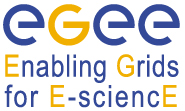Speaker
Dr
Luciano Milanesi
(National Research Council - Institute of Biomedical Technologies)
Description
The aim of the present work is to enable the use of high performance computing infrastructures, such as the EGEE-III Grid Infrastructures for the execution of linkage analysis on very large SNPs (Single Nucleotide Polymorphism) data sets markers. The test has been performed with 10.000 SNPs up to 1 million per Chip.
The linkege analysis of SNPs recently become a very popular approach for epidemiology and genetics population studies for finding the genetics correlation in genetics diseases. The case of Genetic Linkage Analysis, is a statistical method for detecting genetic linkage between disease loci and markers of known locations by following their inheritance in families through the generations. This is a NP-hard problem and the computational cost and memory requirements of the major algorithms proposed in literature grows exponentially with pedigree size and markers' number. Implementations of the mentioned algorithms reflect these limits making analyses of medium/large data sets very hard on a single CPU.
High performance infrastructures based on EGEE Grid has been used for testing this genetics tools for population genetics for achieving whole genome linkage analysis.
The role of Grid computing is getting more and more relevant in biological and medical scientific research due to the high throughput analysis techniques emerging in these fields.
Authors
Alessandro Orro
(Institute of Biomedical Technologies ITB-CNR)
Andrea Calabria
(Institute of Biomedical Technologies ITB-CNR)
Davide Di Pasquale
(Institute of Biomedical Technologies ITB-CNR)
Mr
Gabriele Trombetti
(CNR-ITB)
Gniocchi Matteo
Dr
Luciano Milanesi
(National Research Council - Institute of Biomedical Technologies)
